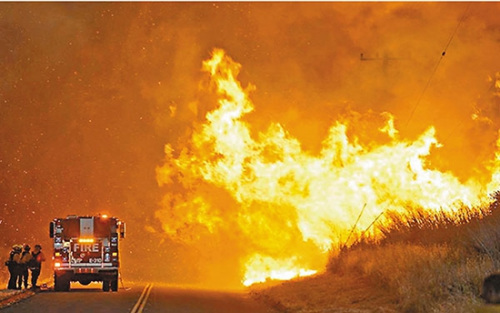(单词翻译:单击)
MORI ROTHMAN: Battalion chief Mike Brown has been fighting fires in California for 26 years. But he's never seen a fire quite like the Blue Cut Fire in southern California's San Bernardino county, 60 miles east of Los Angeles.
MIKE BROWN: It was like an angry fire. These were 50 to 100 foot flame lengths, and I was just amazed to see the volume of the fire.
MORI ROTHMAN: In an ever lengthening wildfire season, Brown is dispatched to fires like this more often — for days at a time. This is his second wildfire in two weeks.
MIKE BROWN: Fires are year round, and we've kinda come to the point that we understand that it's a year round fire season for us.
MORI ROTHMAN: California's wildfire season traditionally began in the summer, when vegetation dried out, and forests became more flammable. But five years of drought and hotter than average temperatures, have shrunk the break between one year's fire season and the next. Drier conditions also contribute to the rapid spread and destructiveness of the fires.
MORI ROTHMAN: What makes a fire like this so dangerous?

MIKE BROWN: The reason why it's so dangerous is the intensity that it's burning. The vegetation was very dense. We had 70 year brush that hadn't been burned. No fire history in this area. Everything was in alignment.
MORI ROTHMAN: Volatile conditions like those in the Blue Cut Fire are becoming more common in other parts of the state — like the Cedar Fire at Sequoia National Forest last week.
Thousands of firefighters have been battling massive wildfires across California this summer, and experts warn this year could be worse than ever. That's because drought, intense heat and tree-eating beetles are causing a dramatic rise in the number of dead trees, turning forests like this one into a tinderbox.
Paul Gibbs is a spokesman for the US Forest Service.
PAUL GIBBS: We've never seen anything at this level and this type of mortality in recorded history that we have. To have 50 to 75 percent of your forest and dead trees — that's unprecedented.
MORI ROTHMAN: Last week, Gibbs deployed to the "cedar fire" in central california to study how the dried out trees fueled the blaze. He says the weather pattern "El Niño" — which typically means wetter conditions for northern and southern california — mostly missed central california. With less rain, grasses and logs dried up earlier in the summer, creating more tinder for fires.
MORI ROTHMAN: People thought maybe El Niño would make this year's wildfire season a little calmer. Has that been the case?
PAUL GIBBS: No, no, we're seeing just the opposite. We did get a pulse of rain, so we have a very healthy grass crop this year. But as we get temperatures in the 90s and over 100, 105, the grass dies. Then you have a combination of the dry grass, which will carry fire and start fires a lot easier.
MORI ROTHMAN: Gibbs is looking for that combination of dry grass and dead trees — hoping to anticipate where the next big wildfire might spark.
PAUL GIBBS: I think we're in store for a pretty active fall. But we've already got folks who've been out for a few days and have to start worrying about fatigue of firefighters, and really pace ourselves because then you realize this is a more like marathon race than a sprint.
MORI ROTHMAN: A marathon that's become the new normal for firefighters like Mike Brown.
MIKE BROWN: We've had numerous fires over the last few months. We have crews coming off of fires, you know coming on to this fire. So crews are taxed we have families that are taxed, so it's been cumbersome not only for firefighters but their families as well.


